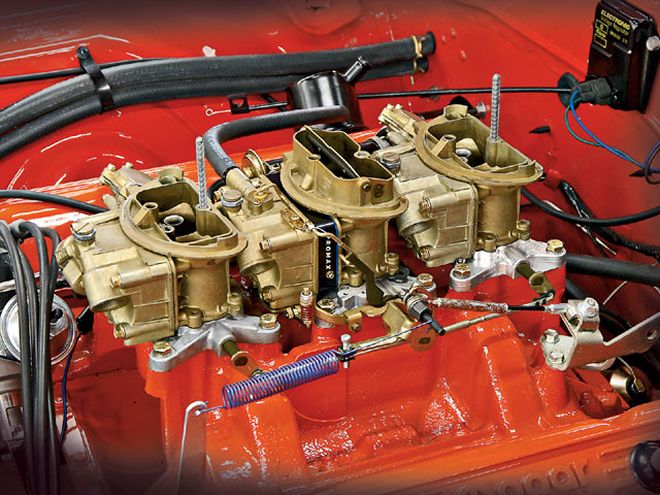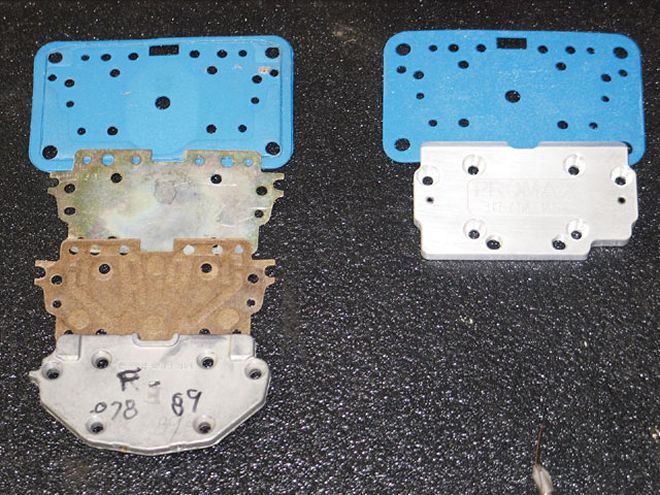
 One perk of the factory Six Pack setup is that you can bolt it on a stock-looking big-block that is anything but, and have plenty of fuel to feed whatever kind of beast you've built.
One perk of the factory Six Pack setup is that you can bolt it on a stock-looking big-block that is anything but, and have plenty of fuel to feed whatever kind of beast you've built.
Just what is it about a Six Pack setup that gearheads find so cool? Yes, they are synonymous with some of Mopar's most powerful engines. Sure, they are one of the most desirable original options. And there's no mistaking their roar when you open them up. Still, few would argue that it's easier to tune a single four-barrel, and most would likely admit that you can get better performance that way.
It's not that they don't work well, because they really do. Even for a radical big-block, 1,350 cfm is plenty of air. It's just that on anything but a stocker (and even then sometimes), they can be a real hassle to get finely tuned. The major stumbling block with this setup is that it, well, has a tendency to stumble when you stab the pedal hard. Part of the problem is the outboard carbs use a fixed metering plate that doesn't have replaceable jets, and they are a vacuum design that lacks accelerator pumps. If the outboards come in too quick, you can experience a slight hesitation. If you hold them back a little, you can avoid the stumble but sacrifice power. Imagine trying to throw open a 1,000-cfm four-barrel with no accelerator pump, and you begin to understand the issue.
Now, if you add a performance camshaft, improve the heads' flow characteristics, and bolt on a free-flowing exhaust, you can count on having to fatten things up a bit in the fuel delivery department. Unfortunately, the only way to do that with the outboard carburetors' stock metering plates is to find ones with different size orifices (have fun with that one), or to carefully drill out the stock plates until you get to where you need to be. That will work, but it's a real pain in the rear to do, and you can't back up if you go too far with the drill size.
 The factory nonadjustable plate has a metering block gasket, then a thin, metal plate, another gasket, and finally the nonadjustable metering plate. By adding the Promax kit, you end up with a metering plate gasket and the adjustable plate.
The factory nonadjustable plate has a metering block gasket, then a thin, metal plate, another gasket, and finally the nonadjustable metering plate. By adding the Promax kit, you end up with a metering plate gasket and the adjustable plate.
Of course, you can't just ignore the idle mixture in this process. The correct idle settings are more critical than you think in order to get the outboard carbs on line smoothly. The center carb is easy since it has a normal metering block, and you can get access to the front idle screws easily, but to get at the rear idle mixture screws, you have to remove the carb. Again, you can do this, but you can imagine the frustration of trying to adjust a carburetor off the engine.
This was the situation the guys at Muscle Car Restorations encountered with Ed Nasser's T/A. Ed's 440 had been rebuilt with a set of Edelbrock aluminum heads and a Comp Cams 298/288 degree/.528 lift cam; tti headers were installed. While the carbs worked great during the Mustang dyno tune, they did stumble a bit out on the street, so Ed obtained a ProMax conversion kit made specifically for the '69-'71 Mopar Six Packs.
Promax manufactures billet replacement metering plates for the outboard carburetors that use standard Holley main jets, and a replacement baseplate that has angled idle screws that are accessible while the rear carb is mounted on the manifold. Ed also had the guys at MCR install one of the Promax billet metering blocks on the center carb.
As expected, when the car was hooked up to the O2 meter, it showed the carburetors were running a little lean and some adjustments needed to be made. The center carburetor was not that far off-just one size up, from a 65 jet size to a 66. But the outboard carburetors jumped from a staggered 78/82 configuration to 84s at all four locations. Now when you mash the pedal on this big-block, it shows no signs of timidity. It just goes!